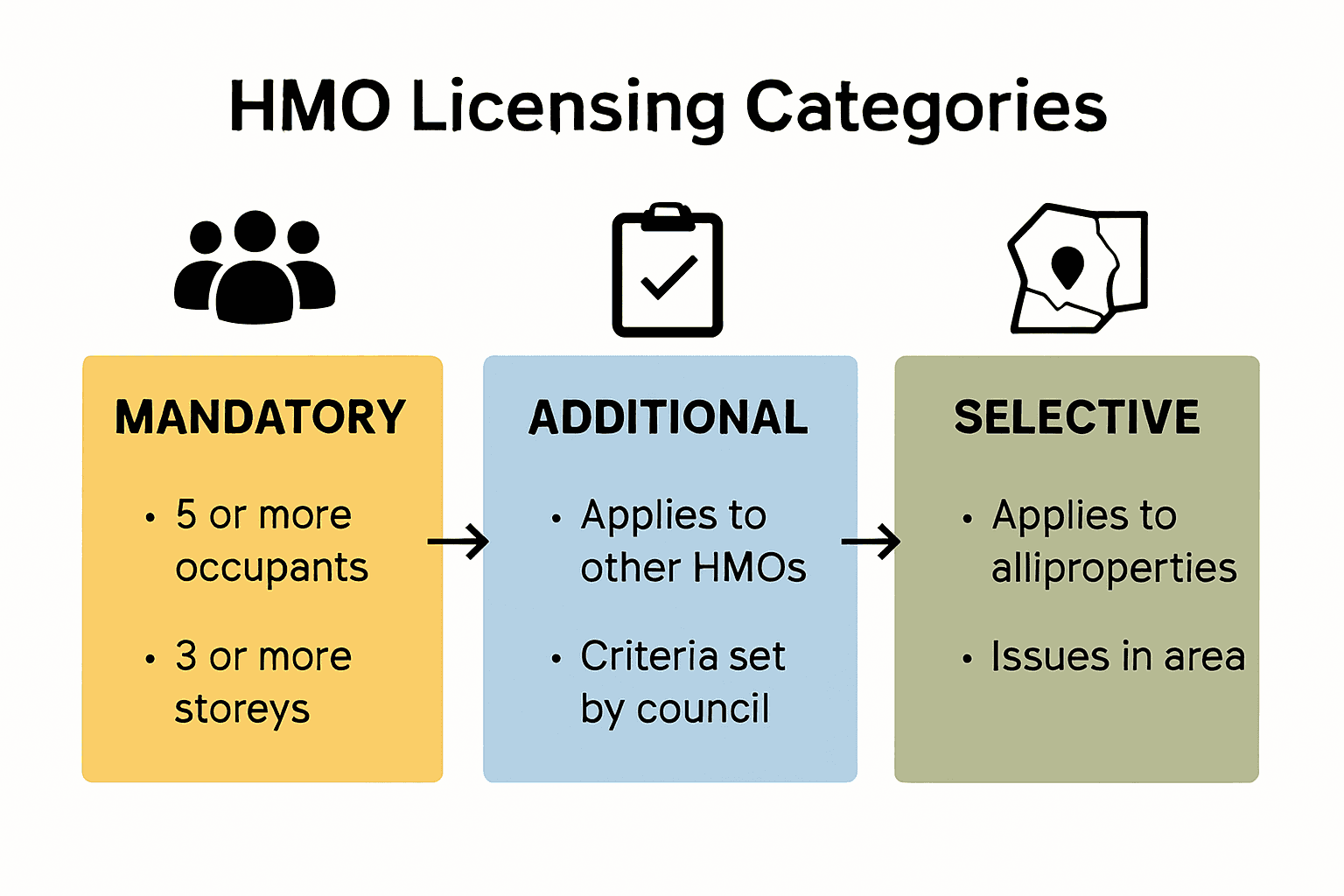Did you know that the number of properties classified as Houses in Multiple Occupation (HMOs) soared after the 2018 legal changes removed the three-storey rule? This shift affects thousands of landlords across the UK, who face a complex web of rules and frequent misconceptions. Understanding what truly defines an HMO—and the real legal and safety responsibilities—helps property owners avoid penalty traps while ensuring safe, modern living spaces for tenants.
Key Takeaways
| Point | Details |
|---|---|
| Understanding HMOs | A House in Multiple Occupation (HMO) is defined as a property with three or more tenants from different households sharing amenities, which can have significant regulatory implications. |
| HMO Licensing Categories | There are three main licensing categories for HMOs: Mandatory, Additional, and Selective, each with specific criteria and local council authority. |
| 2025 Regulatory Changes | Upcoming changes will introduce stricter safety, compliance, and energy efficiency standards, requiring significant upgrades and compliance management from landlords. |
| Landlord Responsibilities | Landlords face heightened legal obligations including comprehensive documentation, issuing contracts, and ensuring property standards to avoid severe penalties and legal liabilities. |
Defining HMOs and Common Misconceptions
A House in Multiple Occupation (HMO) is a property with a unique legal definition that catches many landlords and property investors off guard. According to the Housing Act 2004, an HMO exists when three or more tenants from different households share common amenities like kitchens or bathrooms. This seemingly straightforward definition masks a complex regulatory landscape that has significant implications for property management and investment strategies.
The 2018 legislative updates dramatically simplified HMO classification by removing the previous three-storey requirement, substantially broadening the scope of what constitutes an HMO across the United Kingdom. This change means properties of varying sizes and configurations might now require specific licensing and compliance measures. For instance, a two-storey shared house with multiple tenants could now legally be classified as an HMO, dramatically changing potential investment and operational considerations.
Common misconceptions about HMOs can lead to costly mistakes. Many property investors incorrectly assume that:
- Only large properties with multiple floors qualify as HMOs
- HMO regulations are uniform across all UK regions
- Licensing requirements are optional or minimal
- Conversion to an HMO is a simple, straightforward process
Understanding these nuanced regulations is crucial. For a deeper exploration of HMO license types, explore our comprehensive guide on HMO licenses.
Types of HMOs and Licensing Categories
The world of HMO licensing is far more complex than most property investors realize. Three primary licensing categories shape the regulatory landscape for Houses in Multiple Occupation in the UK, each with distinct requirements and implications. According to housing regulations, these categories are designed to ensure tenant safety and proper property management across different property types and scenarios.
The first category is Mandatory HMO Licensing, which applies to properties housing five or more tenants from multiple households. These properties require compulsory licensing to ensure they meet stringent safety and management standards. Interestingly, learn more about the nuanced licensing process in our comprehensive HMO licensing guide, which breaks down the intricate requirements landlords must navigate.
Beyond mandatory licensing, Additional Licensing provides local councils with flexible regulatory power. This category can encompass smaller HMOs with three or more tenants sharing facilities, allowing councils to designate specific licensing requirements based on local housing conditions. A particularly unique subset is Section 257 HMOs, which includes poorly converted self-contained flats that do not meet building regulations – often falling under Additional Licensing schemes.
The third category, Selective Licensing, offers councils broad control by applying to all rental properties in designated areas, not exclusively to HMOs. This expansive approach allows local authorities to address broader housing quality and management issues. Property investors must understand that licensing requirements can vary significantly between different local council jurisdictions, making thorough research and professional guidance essential for compliance.

Here’s a summary of the three primary HMO licensing categories in the UK:
| Licensing Category | Applies To | Authority Level | Key Requirements |
|---|---|---|---|
| Mandatory Licensing | 5+ tenants Multiple households |
Nationwide (statutory) | Compulsory licence Strict safety standards |
| Additional Licensing | Smaller HMOs 3+ tenants |
Local council discretion | Flexible criteria Varies by region |
| Selective Licensing | All private rentals in chosen areas | Local council discretion | Applies beyond HMOs Varies by area |
Key 2025 HMO Regulation Changes
The 2025 HMO regulatory landscape is undergoing transformative changes that will significantly impact property investors and landlords. Renters’ Rights Bill introduces groundbreaking shifts, most notably the abolition of Section 21 no-fault evictions, which fundamentally reshapes tenant-landlord relationships and provides unprecedented protection for renters in Houses in Multiple Occupation (HMOs).
Fire safety and property standards have become paramount, with new regulations mandating extensive upgrades. According to recent housing research, HMO properties must now implement enhanced fire safety measures, including interlinked smoke and heat detectors and fire-resistant doors. These modifications are substantial, with retrofit costs averaging £41,000 per property. Explore our comprehensive guide on 2025 HMO legal requirements to understand the full scope of these critical changes.
Additionally, 2025 sees significant expansions in local council licensing powers. Councils have extended licensing to smaller HMOs with three tenants and implemented more stringent Article 4 planning restrictions in urban areas like Leeds and Bristol. These changes require landlords to seek explicit permission for property conversions, adding layers of complexity to HMO investments.
Energy efficiency standards have also evolved dramatically. The new regulations mandate Energy Performance Certificate (EPC) Band C for HMOs by 2025-26, pushing landlords to invest in substantial property improvements.
 Moreover, the introduction of ‘Awaab’s Law’ accelerates damp and mould remediation processes, placing additional responsibility on landlords to maintain higher property standards and tenant health and safety.
Moreover, the introduction of ‘Awaab’s Law’ accelerates damp and mould remediation processes, placing additional responsibility on landlords to maintain higher property standards and tenant health and safety.
Mandatory Safety and Compliance Standards
For HMO property investors and landlords, safety and compliance are no longer optional extras but critical legal requirements. The 2025 regulatory landscape demands comprehensive safety measures that go far beyond traditional property management approaches, transforming how HMO properties are maintained and operated.
Fire safety emerges as a paramount concern, with stringent new regulations mandating multiple protective measures. Landlords must now install interlinked smoke and heat detectors, implement robust fire risk assessments, and ensure fire doors meet specific safety standards. These requirements are not merely recommendations but legally enforced obligations that carry significant penalties for non-compliance. Discover the detailed safety compliance checklist in our comprehensive guide, which breaks down each critical requirement.
Beyond fire safety, the Housing Health and Safety Rating System (HHSRS) continues to play a crucial role in property compliance. Landlords must proactively address Category 1 hazards, which include critical issues like damp, mould, and inadequate heating. This means not just identifying these problems but implementing comprehensive remediation strategies that ensure tenant health and well-being.
Energy efficiency standards have also become increasingly strict, with mandatory upgrades required to achieve Energy Performance Certificate (EPC) Band C ratings. These requirements push landlords towards significant property improvements, involving enhanced insulation, more efficient heating systems, and sustainable building practices. The message is clear: modern HMO properties must prioritize tenant safety, comfort, and environmental sustainability in equal measure.
Landlord Duties and Legal Liabilities
The 2025 regulatory landscape has dramatically transformed landlord responsibilities, creating a complex web of legal obligations that demand meticulous attention and proactive management. HMO property owners must now navigate an intricate framework of requirements that extend far beyond traditional property management approaches.
Legal liabilities have become increasingly stringent, with potential consequences ranging from substantial civil fines to criminal prosecution. Landlords must maintain comprehensive documentation, including up-to-date licensing schemes, safety certificates, and precise room size standards. Explore our detailed HMO legal checklist to ensure complete compliance, which can help prevent costly legal missteps.
Specific statutory duties now include critical obligations such as issuing occupation contracts within specified timeframes, conducting mandatory electrical safety checks every five years, and installing mains-wired smoke and carbon monoxide alarms. Failure to comply can result in severe penalties, including rent repayment orders and potential inclusion on the Rogue Landlord Database – a public registry that can permanently damage a landlord’s professional reputation.
Moreover, the concept of fitness for human habitation has been significantly expanded, requiring landlords to proactively address not just physical property conditions, but also tenant health and safety considerations. This holistic approach means continuous property maintenance, prompt hazard remediation, and a commitment to creating safe, habitable living environments that meet increasingly rigorous regulatory standards.
Penalties, Enforcement, and Appeals Process
The 2025 HMO regulatory framework introduces a multi-tiered enforcement mechanism that transforms how local authorities address non-compliance, creating a robust system of accountability for property owners. Councils now possess unprecedented powers to investigate, penalize, and remedy regulatory breaches across Houses in Multiple Occupation (HMOs).
Enforcement primarily occurs through systematic Housing Health and Safety Rating System (HHSRS) inspections, conducted systematically every five years. These comprehensive assessments identify potential hazards and breaches, with local councils empowered to take immediate action on Category 1 hazards. Penalties can escalate rapidly, ranging from substantial financial fines to potential criminal prosecution. Navigate the complex enforcement landscape with our comprehensive legal compliance guide, which provides critical insights into managing potential regulatory risks.
The appeals process has been streamlined to provide landlords with clear pathways for challenging enforcement actions. Landlords can now submit formal appeals through local council tribunals, with specific timeframes and documentation requirements. Key appeal grounds include demonstrating substantial compliance efforts, challenging the severity of identified hazards, or proving mitigating circumstances that warrant reconsideration.
Moreover, councils in urban areas like Leeds and Bradford have implemented nuanced local enforcement strategies. These localized approaches mean that regulatory interpretation and penalty structures can vary significantly between jurisdictions. Landlords must remain vigilant, continuously monitoring local council updates and maintaining meticulous records to effectively navigate these complex regulatory waters.
Take the Stress Out of HMO Regulation Changes
Worried about keeping up with the UK’s latest 2025 HMO laws and avoiding costly compliance mistakes? As highlighted in our guide, navigating complex licensing categories, fire safety upgrades, and evolving council enforcement can be overwhelming. Many landlords and investors feel uncertain about how to protect their properties and tenants while maximising investment returns. Missed details can mean heavy penalties, lost income, or even being listed on the Rogue Landlord Database. You don’t have to manage this alone.
Turn uncertainty into opportunity with expert support from the UK’s dedicated HMO property hub. At AgentHMO, you can connect instantly with trusted estate agents, property managers, and compliance experts specialising in HMO investments. Search for professional services or tap into expert guidance designed for every stage of HMO ownership. Why risk falling behind as regulations change? Visit https://agenthmo.co.uk today and take control of your HMO future with personalised solutions, property listings, and a supportive community ready to help you thrive.
Frequently Asked Questions
What is an HMO?
A House in Multiple Occupation (HMO) is a property where three or more tenants from different households share basic amenities like kitchens or bathrooms, as defined by the Housing Act 2004.
What are the types of HMO licensing?
There are three primary licensing categories: Mandatory Licensing for properties with five or more tenants, Additional Licensing for smaller HMOs with three or more tenants, and Selective Licensing which applies to all rental properties in certain designated areas.
What are the key changes to HMO regulations in 2025?
Significant changes include the abolition of Section 21 no-fault evictions, enhanced fire safety standards, and stricter energy efficiency requirements, mandating that HMOs achieve at least an Energy Performance Certificate (EPC) Band C by 2025-26.
What are the penalties for non-compliance with HMO regulations?
Landlords may face substantial civil fines, potential criminal prosecution, and reputational damage through inclusion on the Rogue Landlord Database for not adhering to safety and compliance standards.



